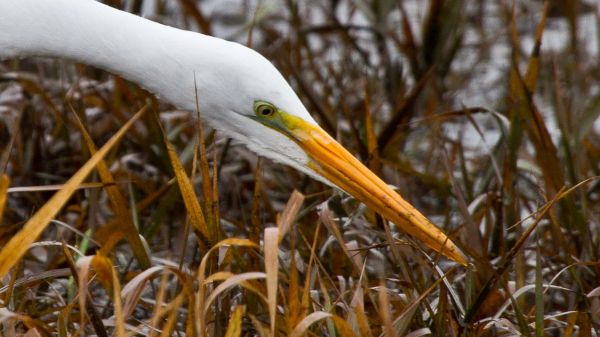eeRESEARCH Feature: EE Supports Conservation Outcomes

This post is part of an eeRESEARCH Library reader engagement series. In collaboration with NAAEE, Duke University is highlighting recent research on relevant topics to help EE practitioners learn from academic literature. This month, we’ve pulled together information from eeRESEARCH summaries about positive conservation outcomes to celebrate a recent research project funded by eeWORKS.
Environmental educators take many forms, from classroom teachers to park rangers to museum educators, and many positions in between. In such a diverse field, we all came into this work for a similar reason: to share our love of nature with others, connect them to their environment, and hopefully make a positive impact on our planet. Though, as environmental educators, it sometimes feels difficult to know if we’re actually making that difference we set out to make. Are our programs helping to shape attitudes and behavior around the environment? Are we influencing the next generation of conservation leaders? We have evaluations, sure, but we cannot follow each of our program participants over the next month, year, or, ideally, twenty years to know if our EE programs made a difference. Further, we are often under pressure to produce data about the outcomes of our work; there is constant demand, understandably, from funders and our organizations to tell them how we’re making a difference—for people and the environment.
eeWORKS, a collaborative project led by NAAEE in partnership with various universities, foundations and government agencies, recently set out to better understand this very question by asking: how can environmental education improve environmental quality by influencing behavior? Researchers worked to understand “environmental education’s role in developing, supporting, and sustaining individuals' and communities' environmental actions that have direct, positive impacts on environmental quality and conservation outcomes.”
After reviewing more than 100 EE studies, researchers found evidence that environmental education supports positive conservation outcomes in five key ways.
First, the study found that environmental education helps to build the knowledge, skills, and intentions to adopt environmental behaviors. Studies have shown that this increase in knowledge can be accomplished through both direct (field) and indirect (indoor) nature experiences.
Second, the study found that EE programming helps participants to adopt environmental behaviors. This is especially true when activities and workshops focus on one or two specific behaviors and address the barriers and motivations around those behaviors.
Third, EE helps the public to take direct environmental action, which makes them a part of, instead of apart from, the natural world. An individual’s drive to take action has been linked to life experiences in nature and interactions with environmental organizations, both of which EE provide.
Fourth, the study found that EE aids in building community capacity for effectively addressing environmental issues, such as improving wildfire preparedness through neighborhood events and networks or increasing environmental literacy with green jobs.
Lastly, this study found that environmental education contributes to conservation outcomes by leading to direct improvement of the environment. This can be accomplished through a wide variety of ways, including campus sustainability projects, youth stewardship programs, and other hands-on, place-based volunteer activities.
The even better news? Many of the studies reported that environmental education achieves more than one conservation outcome at a time.
Additionally, this study found that environmental education programs that produced positive conservation outcomes used four common strategies. Strategy 1 is to choose topics with a local focus and community connections, such as those that help to build social capital. This is a common theme in projects such as community gardens and collaborating with indigenous cultures but varies based on community needs and interests. Strategy 2 is that successful programs form partnerships with scientists and resource managers from local agencies and organizations. Strategy 3 is to incorporate action projects that help address some aspect of the problem. Many of us may be familiar with community science projects, such as bioblitz programs, as an effective form of this. Strategy 4 highlights being intentional, creative, and thorough in measuring and reporting outcomes, as well as explicitly designing programs around conservation goals. This was common among those EE programs that produced successful conservation outcomes. While it can be a heavy lift to incorporate all four of these strategies, selecting one or more can help us to create programs that lead to conservation outcomes.
This study reminds us that just as EE takes many forms, so do the positive conservation outcomes that result from programming. So you can set that worry aside, if only for a moment: you are making a difference. Your work is impacting people and the environment, one program at a time. Thank you for what you do, you world-changing EE rockstar. Keep it up.
Summaries Cited
Ardoin, N. M., Bowers, A. W., & Gaillard, E. (2020). Environmental education outcomes for conservation: A systematic review. Biological Conservation, 241, 108224. https://doi.org/10.1016/j.biocon.2019.108224
Bang, M., Curley, L., Kessel, A., Marin, A., III, E. S. Suzukov, & Strack, G.. (2014). Muskrat theories, tobacco in the streets, and living Chicago as Indigenous land. Environmental Education Research, 20(1), 37 - 55. presented at the 2014/01/02/. Retrieved from http://dx.doi.org/10.1080/13504622.2013.865113
Carmi, N., Arnon, S., & Orion, N.. (2015). Seeing the forest as well as the trees: general vs. specific predictors of environmental behavior. Environmental Education Research, 21(7), 1011 - 1028. presented at the 2015/10/03/. Retrieved from http://dx.doi.org/10.1080/13504622.2014.949626
DuBois, B., Krasny, M. E., & Smith, J. C.. (2018). Connecting brawn, brains, and people: An exploration of non-traditional outcomes of youth stewardship programs. Environmental Education Research, 24(7), 937-954. doi:http://dx.doi.org/10.1080/13504622.2017.1373069
Duerden, M. D., & Witt, P. A.. (2010). The impact of direct and indirect experiences on the development of environmental knowledge, attitudes, and behavior. Journal of Environmental Psychology, 30(4), 379-392. doi:http://dx.doi.org/10.1016/j.jenvp.2010.03.007
Fakharzadeh, S. (2015). Food for thought: The intersection of gardens, education, and community at Edible Schoolyard New Orleans. Children, Youth and Environments, 25(3), 175-187.
Goralnik, L., & Nelson, M. P.. (2011). Framing a Philosophy of Environmental Action: Aldo Leopold, John Muir, and the Importance of Community. The Journal of Environmental Education, 42(3), 181 - 192. presented at the 2011/03/16/. Retrieved from http://dx.doi.org/10.1080/00958964.2010.526152
Griswold, Wendy. (2013). Community Education and Green Jobs Acknowledging Existing Connection. Adult Learning. 24. 30-36. 10.1177/1045159512467322.
Hintz, C. J., & Lackey, B. K.. (2017). Assessing community needs for expanding environmental education programming. Applied Environmental Education & Communication, 16(4), 287 - 297. presented at the 2017/10/02/. Retrieved from https://doi.org/10.1080/1533015X.2017.1348270
Krasny, M. E., & Delia, J.. (2014). Campus sustainability and natural area stewardship: student involvement in adaptive comanagement. Ecology and Society, 19(3), 27. presented at the 2014///. Retrieved from http://www.ecologyandsociety.org/vol19/iss3/art27/ES-2014-6787.pdf
Krasny, M. E., Kalbacker, L., Stedman, R. C., & Kudryavtsev, A.. (2015). Measuring social capital among youth: applications in environmental education. Environmental Education Research, 21(1), 1 - 23. presented at the 2015/01/02/. Retrieved from http://dx.doi.org/10.1080/13504622.2013.843647
Li, D., & Chen, J.. (2015). Significant life experiences on the formation of environmental action among Chinese college students. Environmental Education Research, 21(4), 612 - 630. presented at the 2015/05/19/. Retrieved from http://dx.doi.org/10.1080/13504622.2014.927830
Monroe, M. C., Agrawal, S., Jakes, P. J., Kruger, L. E., Nelson, K. C., & Sturtevant, V.. (2013). Identifying Indicators of Behavior Change: Insights From Wildfire Education Programs. The Journal of Environmental Education, 44(3), 180 - 194. presented at the 2013/01/01/. Retrieved from http://dx.doi.org/10.1080/00958964.2012.746277
Monroe, M. C., Ballard, H. L., Oxarart, A., Sturtevant, V. E., Jakes, P. J., & Evans, E. R.. (2016). Agencies, educators, communities and wildfire: partnerships to enhance environmental education for youth. Environmental Education Research, 22(8), 1098 - 1114. presented at the 2016/11/16/. Retrieved from http://dx.doi.org/10.1080/13504622.2015.1057555
Postles, M., & Bartlett, M.. (2018). The rise of BioBlitz: Evaluating a popular event format for public engagement and wildlife recording in the United Kingdom. Applied Environmental Education & Communication, 17(4), 365 - 379. presented at the 2018/10/02/. Retrieved from
Stern, M. J., Powell, R. Baxter, & Hill, D.. (2014). Environmental education program evaluation in the new millennium: what do we measure and what have we learned?. Environmental Education Research, 20(5), 581 - 611. presented at the 2014/09/03/. Retrieved from http://dx.doi.org/10.1080/13504622.2013.838749















Comments
Thank you for sharing Chelsea! We often don't get to see these big picture impacts and it's really reinforcing to read about these desirable consequences of our collective efforts. I look forward to digging in deeper and see lots of value in sharing these outcomes with partners and funders. Best, Jason